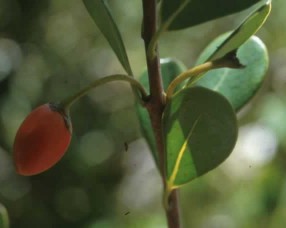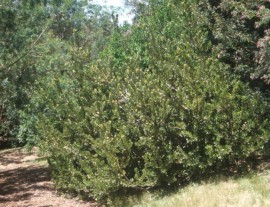Mimusops caffra
Mimusops caffra E.Mey. ex. A.DC
Family: Sapotaceae
Common names: coast red milkwood (Eng.); kusrooimelkboom, moepel (Afr.); umhayihayi amasethole-abomvu, umthunzi, umnweba waselwandle, umnole, umagayi, umkhakhayi (Zulu); umhlophe (Xhosa)
SA Tree No: 583
Introduction
Gardeners looking for a tree suitable for coastal gardens with windy conditions should not look any further-this tree is a good choice, particularly for east coast gardeners.

Description
Description
Mimusops caffra is a small to medium-sized tree up to 15 m high. In an exposed habitat it forms a shrub. The bark is dark grey, thin and wrinkled longitudinally. The young stems are densely covered with long, rust-coloured hairs. The wood is reddish, closely grained, heavy, hard, strong and elastic.

The leaves are obovate to obovate-oblong, 30-70 x 15-40 mm. They are stiffly leathery, without hairs and blue-green above. They are paler green with white, silvery or yellowish silky hairs below. The apex is round and frequently notched. The leaf margin is entire and strongly rolled under. The petiole is up to 15 mm long. The flower has rust-coloured, haired sepals; petals are white to cream shaped like a star. The flowers are on slender stalks in auxiliary groups of 2 to 4. The fruits are fleshy, bright orange-red when mature. They are edible and pleasantly sweet.
Conservation Status
Status
Mimusops caffra is protected in terms of the National Forest Act of 1998. Protected tree species may not be cut, disturbed, damaged or destroyed, and their products may not be possessed, collected, removed, transported, exported, donated, purchased or sold, except under license granted by the Department of Water Affairs and Forestry or a delegated authority.
Distribution and habitat
Distribution description
Its natural habitat is dune forest from the high tide mark in KwaZulu-Natal and the former Transkei region. It is also found in Mozambique . This tree is common from Port Alfred and Bathurst in Eastern Cape to Maputo in Mozambique . It forms up to 75% of the coastal and dune forest and flourishes even within reach of the salty sea sprays. It is found in abundance in Durban as it grows along coastal roads to the north and south.
Derivation of name and historical aspects
History
The genus Mimusops is based on the Greek words, mimo meaning ape, and ops meaning resembling (Palmer & Pitman 1972). Perhaps Linnaeus fancied the flowers of Mimusops with their brownish red, furry, calyx lobes, resembling in miniature, the faces of monkeys. The Zulu common name umThunzi (shade tree) was the name given to a shady tree of the species near Umlalazi Lagoon, under which Chief John Dunn held court. The village there is now known as mThunzini. The name red milkwood is based on the colour of the wood and on its milky latex. Moepel is derived from a North Sotho name for Mimosops zeyheri and is applied to all the South African Mimusops species. South Africa has only three species that belong to the genus Mimusops; M. caffra, M. obovata and M. zeyheri.
Ecology
Ecology
The red or orange-red fruits are the staple food of the monkeys along the coastal forests of KwaZulu-Natal. Cape parrots in the coastal forests of the Eastern Cape are also fond of the fruit. Blackbellied glossy starlings, Yellowstreaked bulbuls and bushpigs also eat the fruit. Monkeys in particular spread the seed.
Uses
Use
In KwaZulu-Natal, Mimusops caffra is considered a royal timber tree of excellent quality. Its tough timber is in demand for local boat-building. The wood is also used to make the framework of the large conical fish trap that fishermen use.

Growing Mimusops caffra
Grow
Mimusops caffra is grown from seed. The best time to sow seed is in summer. Treat the seed with fungicide before sowing to prevent damping off. It is also grown from cuttings. Dip cuttings in a rooting hormone. Use fine bark with polystyrene as the growing medium. Put the cutting in a mist unit with under-heating. It will take four to six weeks for roots to develop. After rooting, the cuttings should be removed to harden off and then potted into bags.
References
- Coates Palgrave, K. 1977. Trees of southern Africa, edn 2. Struik, Cape Town.
- Palmer, E. & Pitman, N. 1972. Trees of southern Africa, vol. 3. Balkema, Cape Town.
- Pooley, E. 1993. The complete field guide to trees of Natal, Zululand and Transkei. Natal Flora Publications Trust, Durban.
Credits
Giles Mbambezeli
Kirstenbosch National Botanical Garden
August 2006
Plant Attributes:
Plant Type: Tree
SA Distribution: Eastern Cape, KwaZulu-Natal
Soil type: Sandy
Flowering season:
PH: Neutral
Flower colour: White, Cream
Aspect: Full Sun
Gardening skill: Easy
Special Features:
Horticultural zones









Rate this article
Article well written and informative
Rate this plant
Is this an interesting plant?
Login to add your Comment
Back to topNot registered yet? Click here to register.